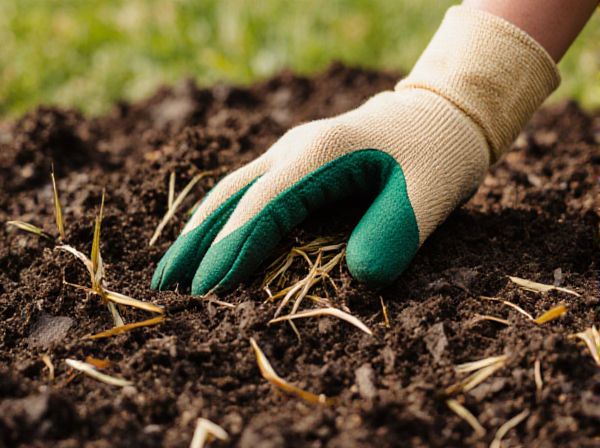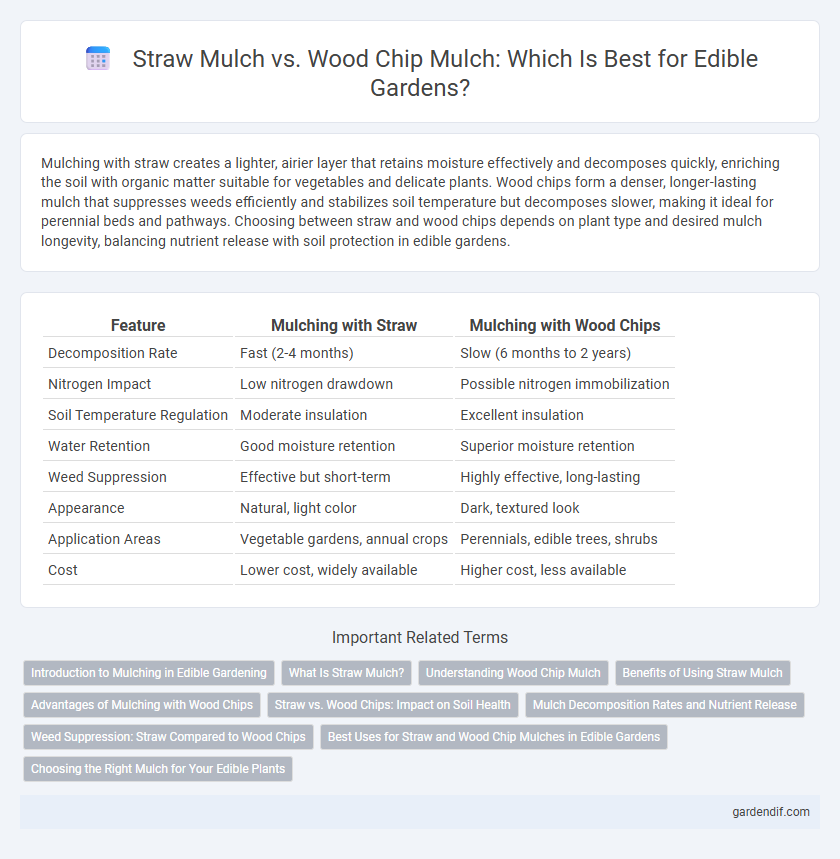
Mulching with straw vs mulching with wood chips Illustration
Mulching with straw creates a lighter, airier layer that retains moisture effectively and decomposes quickly, enriching the soil with organic matter suitable for vegetables and delicate plants. Wood chips form a denser, longer-lasting mulch that suppresses weeds efficiently and stabilizes soil temperature but decomposes slower, making it ideal for perennial beds and pathways. Choosing between straw and wood chips depends on plant type and desired mulch longevity, balancing nutrient release with soil protection in edible gardens.
Table of Comparison
| Feature | Mulching with Straw | Mulching with Wood Chips |
|---|---|---|
| Decomposition Rate | Fast (2-4 months) | Slow (6 months to 2 years) |
| Nitrogen Impact | Low nitrogen drawdown | Possible nitrogen immobilization |
| Soil Temperature Regulation | Moderate insulation | Excellent insulation |
| Water Retention | Good moisture retention | Superior moisture retention |
| Weed Suppression | Effective but short-term | Highly effective, long-lasting |
| Appearance | Natural, light color | Dark, textured look |
| Application Areas | Vegetable gardens, annual crops | Perennials, edible trees, shrubs |
| Cost | Lower cost, widely available | Higher cost, less available |
Introduction to Mulching in Edible Gardening
Mulching in edible gardening enhances soil moisture retention, temperature regulation, and weed suppression, promoting healthier plant growth. Straw mulch decomposes quickly, enriching soil organic matter but may require frequent replenishment, while wood chips offer longer-lasting coverage and improved soil aeration. Choosing between straw and wood chips depends on specific crop needs, local climate, and soil conditions for optimal edible garden productivity.
What Is Straw Mulch?
Straw mulch consists of dried stalks of cereal crops such as wheat, barley, or oats, providing excellent moisture retention and weed suppression in edible gardens. It decomposes relatively quickly, enriching soil organic matter and improving soil aeration, while its light texture allows easy incorporation into garden beds. Compared to wood chips, straw mulch is lighter and more biodegradable, making it ideal for vegetable beds and delicate plants sensitive to mulch acidity.
Understanding Wood Chip Mulch
Wood chip mulch, derived from shredded branches and bark, offers superior moisture retention and weed suppression compared to straw, making it ideal for edible gardens. Its slow decomposition enriches soil organic matter, promoting healthy plant growth and improved nutrient cycling. Unlike straw, wood chips provide long-lasting soil insulation, protecting roots from temperature fluctuations and reducing erosion.
Benefits of Using Straw Mulch
Straw mulch improves soil moisture retention by creating a breathable barrier that reduces evaporation and moderates soil temperature, which is essential for vegetable growth and root development. Its high carbon-to-nitrogen ratio promotes beneficial microbial activity as it decomposes, enhancing soil fertility without causing nitrogen depletion. Straw mulch also suppresses weed growth effectively while being lightweight and easy to apply, making it a sustainable choice for edible gardens.
Advantages of Mulching with Wood Chips
Mulching with wood chips enhances soil moisture retention and improves aeration more effectively than straw, promoting healthier root development in edible plants. Wood chips decompose slowly, providing long-term nutrient release and reducing the frequency of mulch replacement. This durable mulch also suppresses weed growth efficiently while maintaining soil temperature stability, which benefits crop yield and quality.
Straw vs. Wood Chips: Impact on Soil Health
Straw mulch decomposes faster than wood chips, providing a quicker release of nutrients and enhancing soil organic matter more rapidly. Wood chips offer longer-lasting coverage, improving soil moisture retention and reducing erosion while slowly contributing to soil carbon content. Both mulches support beneficial microbial activity, but straw is better suited for annual crops due to its nutrient boost, whereas wood chips favor perennial plant systems by maintaining stable soil structure.
Mulch Decomposition Rates and Nutrient Release
Mulching with straw decomposes faster than wood chips, resulting in quicker nutrient release into the soil, which benefits short-term nutrient demands for edible plants. Wood chips break down more slowly, providing a longer-lasting mulch layer that improves soil structure and moisture retention over time. Selecting straw favors rapid nutrient cycling, while wood chips support sustained soil health and gradual nutrient availability.
Weed Suppression: Straw Compared to Wood Chips
Straw mulch provides effective weed suppression due to its dense, fine texture that blocks sunlight and inhibits weed seed germination. Wood chips also suppress weeds but may allow more light penetration between larger pieces, potentially enabling some weed growth. Straw decomposes faster, necessitating more frequent replacement, while wood chips create a longer-lasting barrier against weeds in edible gardens.
Best Uses for Straw and Wood Chip Mulches in Edible Gardens
Straw mulch excels in vegetable beds and around root crops by retaining soil moisture and suppressing weeds while decomposing quickly to enrich the soil with organic matter. Wood chip mulch is ideal for perennial fruit trees and berry bushes, providing long-lasting weed control and improving soil structure over time due to its slower decomposition rate. Both mulches protect plants from temperature fluctuations, but selecting based on crop type maximizes growth and soil health benefits in edible gardens.
Choosing the Right Mulch for Your Edible Plants
Straw mulch offers excellent moisture retention and weed suppression, making it ideal for vegetable gardens and delicate edible plants sensitive to soil temperature fluctuations. Wood chips provide long-lasting coverage and slowly enrich the soil with organic matter, benefiting perennial edible plants like berry bushes and fruit trees. Selecting the right mulch depends on your plant type, soil needs, and desired maintenance level for optimum growth and yield.
Mulching with straw vs mulching with wood chips Infographic

 gardendif.com
gardendif.com